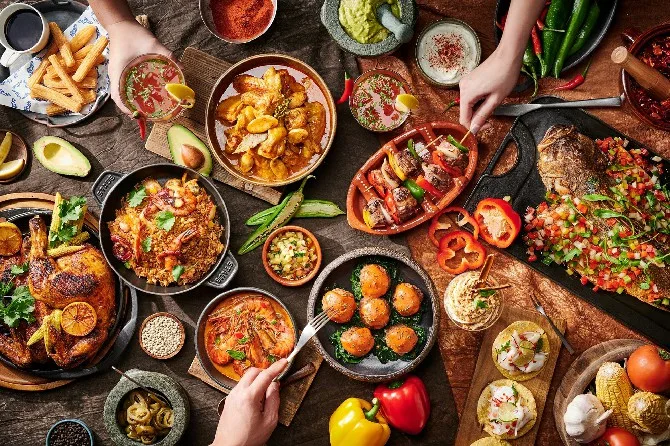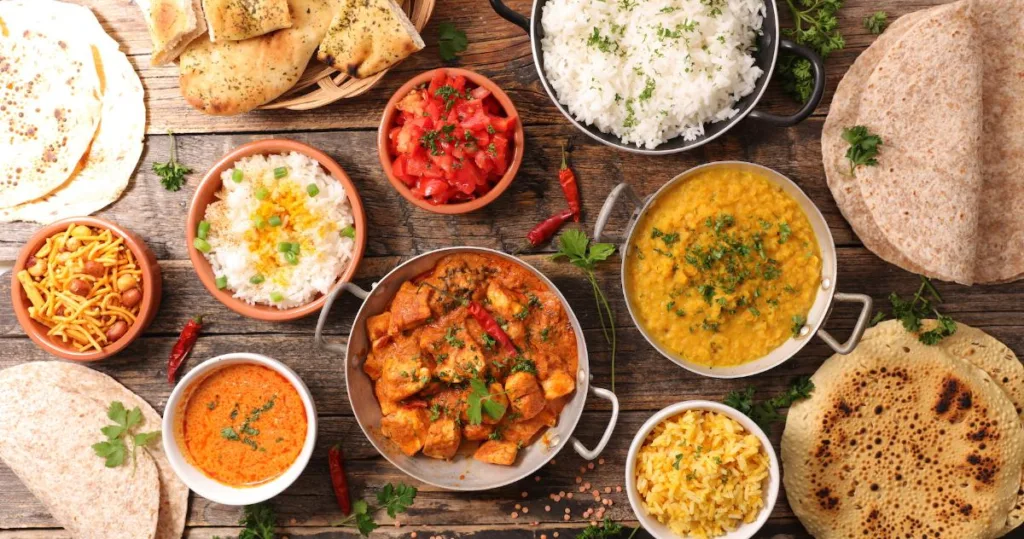Food brings us together. It weaves through cultures and time, telling stories with each bite. Meals become memories that nourish us long after the plates are clean. But can global cuisines really help us on our path to better health? As a passionate home cook and nutrition enthusiast, I’m convinced traditional ways of eating hold wisdom for balancing flavor and wellbeing.
This idea first sparked several years ago during a late night noodle run. My friend Stephanie and I were pulling another all-nighter to cram for finals, fueled by vending machine snacks and stale coffee. Around midnight, hunger hit hard. We decided to walk down the block for a hot meal at our favorite Chinese restaurant.
As we slurped salty broth and savored the tender dumplings, I told Stephanie how my doctor said I needed to lose twenty pounds to reach a healthy weight. “No problem!” she said. “We’ll just eat more Chinese food. My whole family’s super skinny.” She detailed their meals of steamed fish, greens stir fried with garlic, noodle soup with veggies. “It’s really healthy stuff.”
This conversation stuck with me over the years. If cultures like Stephanie’s family in China maintained balanced weights and health for generations, what did they know that I didn’t? That late night dumpling craving sparked my journey into the healing potential of global cuisines.
As a culinary nutrition student, I dove deeper into evidence on traditional diets. But textbooks and studies only provided part of the picture. I wanted to experience firsthand how cultures cooked their way to wellness. This curiosity led me to backpacking adventures and kitchen mishaps worldwide, gathering ingredients and inspiration for healthy living.
I hope to share a taste of these experiences through the recipes, stories, and insights on my blog. Food is so much more than nutrients on a label. It’s intimately connected to our health and happiness. Keep this perspective as your compass while navigating your own path to wellbeing. Here’s how cuisines around the world can guide you to weight loss success one bite at a time.
Mediterranean Magic: A Heart-Healthy Lifestyle from the Olive Grove
Hands dusted white with flour, an elderly Greek woman named Agatha showed me how to roll thin, spiraling strands of phyllo dough. We were in the island village of Santorini, taking a cooking class during my two-week backpacking adventure around the Greek islands.
“Ela re, keep up!” Agatha teased as I struggled to mimic her expert folds of the paper-thin sheets into little pouches. We filled them with a lemony spinach mixture, then baked until golden. Savory and crisp, they were the perfect snack.
Agatha, age 75 and waving off any “health issues,” embodied the Mediterranean lifestyle that makes it legendary among nutrition scientists. Her days involved preparing meals with garden-fresh ingredients, walking with friends, tending her orchard of figs and olives, laughing often. In contrast to the American focus on counting calories and macros, she simply followed generations-old food traditions: beans, lentils, whole grains, nuts, greens, herbs, fermented foods like yogurt, moderate meat and fish, quality olive oil, and always shared with others.
This Mediterranean pattern provides proven benefits for weight loss and metabolic health. The abundance of anti-inflammatory foods like vegetables, fruits, nuts and olive oil supply antioxidants to reduce inflammation. Whole grains and beans offer steady energy and fiber. Oily fish like sardines and salmon provide omega-3 fats to balance inflammatory omega-6s from vegetable oils common in modern diets.
Red wine’s antioxidants, when consumed moderately, complement heart-healthy monounsaturated fats from olive oil. Beyond the nutrients, Mediterranean habits like active days, family meals, and leisurely dining prevent overeating and help make healthy eating effortless. This big picture approach targets physical and emotional health for holistic wellbeing.
After parting with hugs from Agatha, her gift of phyllo pouches kept me fueled for more island adventures. When I got home, I kept the Mediterranean magic alive by stocking up on staples like chickpeas, whole grain pittas, nuts, veggies, yogurt, and yes – quality olive oil. Don’t skimp on olive oil! Agatha would be aghast at low-quality from big box stores. Look for regional varieties and brands imported from Greece, Spain or Italy. The nuanced fruitiness enhances veggies or hummus.
For true Mediterranean eating, weave in these staples creatively throughout your week: build a grain bowl with chickpeas, parsley, kalamata olives and feta; pair salmon baked in lemon and olive oil with roasted root veggies; blend Greek yogurt, garlic, lemon and olive oil into a quick veggie dip. Soon, you too can channel your inner Mediterranean nonna!
Asian Cuisine: Balance, Variety and Flavor in Every Bite
During my semester abroad in China, I met the ever-patient Chef Wang who taught me classical Cantonese cooking. Dumplings, fried rice, stir fries – we covered staples every night at 7pm in the dorm’s public kitchen. After one clumsy attempt making pork and ginger dumplings, he smiled kindly and said in Mandarin, “Ayi [Auntie], don’t worry! We keep practicing. Dumpling folds take time.”
Chef Wang, a native of Guangdong province and graduate of a Chinese culinary institute, stressed basics like controlling heat for fast, hot wok cooking. “Patience. We have time,” he would remind me in broken English with a laugh. Beyond recipes, he imparted broader lessons that shaped my view of Chinese cuisine’s balance.
Key elements like rice or noodles made up about 50% of the meal, then 30% dishes like stir fried, steamed or braised meats or vegetables, and 20% soups and light salads. Protein came from varied sources like tofu, beans, eggs, pork, chicken, fish and seafood. Versatile sauces added flavor without a lot of oil, sugar, or salt – like soy sauce, sesame oil, oyster sauce and Shaoxing wine. Leftover rice or meat might reappear fried with an egg as tomorrow’s breakfast. Pickled veggies offered probiotics benefits.
This ancient food wisdom promotes metabolically-healthy weight loss in several ways. Lean proteins, fiber-rich whole grains and a rainbow of vegetable dishes encourage satiety. Chili peppers and ginger add thermogenic compounds to boost calorie burn. Tea sipped with meals aids digestion. Light cooking methods like steaming, boiling and quick stir frying preserve nutrients in vegetables. Fermented foods aid digestion and immunity.
After living in China, I strove to recreate the balanced approach of Chinese meals at home. Aim for a mix of veggies, whole grains, modest proteins, and smaller amounts of healthy fats. Choose ingredients from the perimeter of the grocery store – fresh produce, lean meats, tofu. For authentic flavor in stir fries or broths, use umami seasonings like soy sauce, rice vinegar, toasted sesame oil, oyster sauce and ginger. Then turn up the heat and passion as you channel your inner wok rockstar!

Spice Up Your Life: Caribbean and Latin American Fiesta Flavors
Salsa music drifted through the balmy Puerto Rican night as my friend Marisol and I cooked up a storm in her parent’s kitchen. We were on summer break from university, her family welcoming me into their home for two weeks of beaches and adventures. Now her parents danced in the living room while we prepared classic dishes from family recipes.
“Here, try making the sofrito,” Marisol said, handing me a Puerto Rican cookbook opened to a sauce brimming with onions, garlic, cubanelle peppers and oregano. This flavor base simmers in many Puerto Rican and Latin Caribbean dishes. As we chopped pungent garlic and orange cubanelles, their perforating scent clearing our sinuses, I saw firsthand how this cuisine achieves big flavor without loads of salt, sugar or fat.
Latin Caribbean cuisine emphasizes fresh ingredients accentuated by bold seasoning. Herbs like cilantro, oregano and achiote (annatto) add layers of flavor along with peppers, onions, garlic and citrus. Rice and beans form satisfying staples, supplemented by starchy tubers like yuca and plaintains. Lean proteins like chicken, pork and fish balance indulgent dishes like mofongo fried plantains mashed with garlic and olive oil.
Beyond taste, this spice-forward cuisine gives your metabolism a kickstart through compounds like capsaicin in peppers. The combination of fiber, protein and healthy fats keeps energy balanced and hunger at bay. Vibrant pan-fried vegetables retain antioxidants, particularly when cooked quickly and eaten soon after prepping.
After my Puerto Rican cooking adventures, I returned home eager to recreate the bright, peppy flavors starting with a basic sofrito. Saute one part onion, one part cubanelle or red bell pepper, and 2-4 cloves garlic in olive oil until soft. Add oregano, cumin or annatto for depth. Stir a spoonful into soups, beans, meats or veggies. Serve with freshly fried plantains for a taste of the Caribbean.
With time you can build up your Latin spice tolerance! Start by adding mild peppers, herbs and vinegar to BOOST the flavor in smaller amounts of salt, sugar and fat. Squeeze lime juice over tacos, stir cumin into chickpeas for hummus, or add chili powder to chocolate for mole sauce. Viva la fusion!

Nordic Cuisine: From Forest and Sea, Simplicity at Its Finest
Crisp Nordic air stung my cheeks as I stood ankle-deep in ice cold water, learning to catch langoustine off southern Sweden’s coast. My instructors Olaf and Niklas were weathered fishermen, descended from generations who harvested these seas. Patiently they coached me on catching the spindly, rosy-pink crustaceans hiding in rocky crevices.
After proudly netting a half dozen langoustine, we motored back to a nearby seaside inn where the chef transformed our catch into the region’s ubiquitous dish: langoustine stew. Gentle cooking allowed the sweet shellfish flavor to shine through the cream base infused with dill. Alongside, flaky rye bread and a chilled pilsner balanced the rich, hearty stew.
This meal embodied the essence of Nordic cuisine I observed through my travels in Sweden, Denmark, Norway and Finland. Local, seasonal ingredients take center stage, prepared simply to highlight their character. Despite harsh winters, the Nordic people have mastered coaxing extraordinary flavors out of their natural bounty.
Cold coastal waters yield succulent fish like salmon and trout, while forests offer berries and mushrooms. Root vegetables, beets, cabbages and legumes provide sustenance through long winters, often preserved through pickling, smoking or fermenting. Rye and barley tolerate the region’s poor soils while oats thrive in cool climes, providing whole grain nutrition. Dairy forms a cornerstone, from yogurt to famously high-fat cheeses and creams.
For weight loss, lean proteins and omega-3 rich seafood support metabolism and satiety. Non-starchy vegetables have fewer carbohydrates than their starchier cousins like potatoes. Pickled vegetables promote probiotics for healthy digestion while delivering crunch and tangy contrast to rich dishes. The abundance of grains and dairy can make portion control key – but the Nordic affinity for active outdoor living balances the energy intake.
To enjoy Nordic cuisine’s benefits at home, incorporate fish twice a week, like salmon pan fried in olive oil with dill. Roast hearty root vegetables and cruciferous greens like cabbage or Brussels sprouts. For a taste of tradition, simmer fruit like lingonberries, apples or plums into a sweet-tart compote. Enjoy full fat yogurt and skyr, but watch portions. Overall, let nature guide your choices – fresh, seasonal and local.

French Cuisine: Masters of Quality and Balance
Warm buttery aromas welcomed me into Emile and Celeste’s country kitchen in Provence. Friends of my study abroad host family, they invited me over to learn classic French cooking firsthand. Celeste bustled around the kitchen, casually flicking mushroom bits in parsleyed omelettes pan-searing on the stove, while Emile poured glasses of crisp rosé.
Despite France’s reputation for extravagance, meals like this demonstrated the true foundations of French cuisine through balance, quality and moderation. “Les proportions, c’est la clé!” Emile said emphatically – proportions are key. Each course, from salad greens to cheese plate, hit all the taste senses in modest portions.
This humble meal reflected habits at the heart of French health – daily movement, mindfully savoring food, eating together. While rich pastries and sauces exist, they are truly occasional treats, not everyday fare. Less butter or cream is needed when you start with excellent produce, cheese, eggs, meats and wine.
I noticed even small kitchens like Celeste’s prized having five French copper pots for perfect heat conduction. Seeking peak ripeness motivated shopping daily at the market. Simple preparations allowed premium ingredients to radiate, like a splash of sherry vinegar dressing tender bibb lettuce. Instead of snacking absentmindedly, meals became occasions to gather and nurture both body and soul.
After my lovely evening with Celeste and Emile, I brought their teachings back to my own kitchen. Focus on quality over quantity – splurge on a few excellent cheeses, heirloom greens, or pastured eggs. Savor and appreciate each bite. Share meals with others when possible. Portion control comes naturally when you tune into eating mindfully.
For an elegant yet effortless French-inspired meal, try baking fish or chicken breasts in parchment packets with thinly sliced lemon and herbs. Steam green beans or asparagus to retain brightness. Enjoy a salad of mixed baby greens, shaved fennel and a simple vinaigrette. Finish with crusty bread, wine and a selection of fine cheeses. Vive la France!

Global Cuisines, Timeless Wisdom: Crafting Health Through Food Traditions
What started as a late night dumpling craving unlocked my fascination with global cuisines. I’ve now explored how traditional ways of eating shaped cultures and health around the world. Through cooking classes, kitchen mishaps and meals with welcoming locals, I experienced cuisine’s power to nourish body and spirit.
Some key highlights stuck with me across gastronomic latitudes. Balance and variety at each meal provides satiety and nutrient density. Flavor can burst from plants, spices, vinegars and thoughtfully combined animal foods instead of packing on salt, sugar and fat. Portion sizes stay modest when food is celebrated as part of a lifestyle rather than wolfed down on the run. Sharing meals with others, whether family or fellow travelers, feeds joy as much as our bodies.
While each cuisine has its own flair, together they tell a story of how traditional eating patterns can guide weight loss and wellbeing. Health looks different around the globe – from vegetarian India to the meat and fat-rich diets of the Inuit Arctic tribes. A wonderful diversity of ingredients, techniques and flavors can sculpt satisfying meals. There are many paths to good health through food traditions.
As a passionate home cook and nutritionist, my travels taught life lessons even more valuable than recipes. Keep an open mind and heart to find beauty in all food cultures. Savor each morsel and moment shared around the table. Remember that food choice goes far beyond calories or grams. Ingredients link us to nature, cuisine connects us to community, and meals become memories that nourish our souls.
Wherever your path leads you, keep this spirit of food as an instrument of health and happiness. If my experiences inspire you to sample global flavors, let me know! I’ll share favorite cookbooks, recipes and tips. For now, wishing you delicious adventures wherever food takes you next. Thanks for joining me on this tasty journey!
Want to explore more about food as medicine? Subscribe to our newsletter and receive nutrition tips and recipes monthly. I also invite you to stroll through the other articles here if interested in healthy cooking, meal planning, intuitive eating and achieving your personal wellness goals. However your health journey unfolds, I’m happy you’re here!
Thank you for reading this post, don't forget to subscribe to our free newsletter
!
